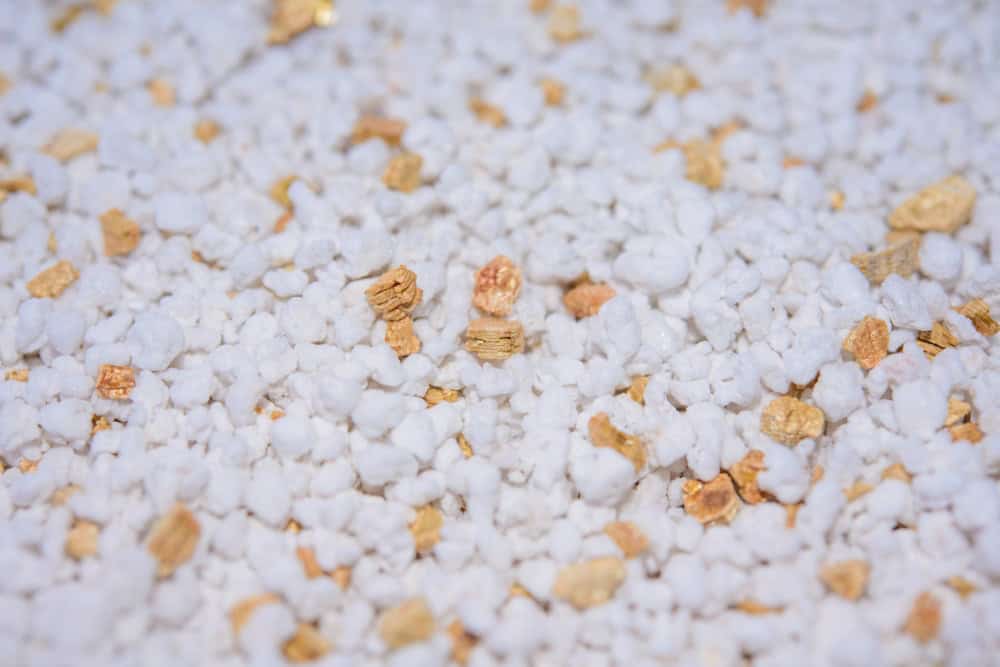What is the Difference Between Perlite and Vermiculite, and Why Should They Be Used Together?

Perlite and vermiculite are two planting materials that help improve soil conditions by increasing the space between soil particles and air. They are ideal for planting. This article will explain what perlite and vermiculite are and how to use them correctly with other planting materials.
What are Perlite and Vermiculite?
Perlite and vermiculite are popular planting materials used to mix with soil, peat moss, or other planting materials to improve soil conditions for plant growth. Both have unique properties as described below:
Perlite
Perlite is a naturally occurring volcanic mineral, often referred to as volcanic glass, containing water. When heated to approximately 900°C, the water inside evaporates, causing it to expand and break into small, lightweight white granules that resemble foam. It is porous, promotes excellent drainage and aeration, and helps retain soil moisture without waterlogging. It is suitable for plants requiring loose soil.
Vermiculite
Vermiculite is a silicate mineral with a layered structure. When heated to 800-1000°C, it expands into thin, stacked layers. It is typically brown, golden, or gray in color and is porous, enabling excellent water and nutrient retention. Vermiculite is also effective in exchanging nutrients for plants, making it ideal for moisture-loving plants.
Similarities Between Perlite and Vermiculite
- Both are natural minerals. Perlite and vermiculite are natural minerals that undergo heat treatment to develop a porous structure.
- Lightweight. Both are lightweight, reducing the weight of soil mixtures. This makes them suitable for potted plants, hanging plants, or shelf plants.
- Safe for plants. Neither contains harmful chemicals or toxins, making them safe for planting without adverse effects on plants.
Differences Between Perlite and Vermiculite
- Structure. Perlite consists of porous granules, while vermiculite is made up of thin, layered sheets.
- Color. Perlite is typically white or light gray, whereas vermiculite ranges from brown, golden, to gray.
- Water retention capacity. Perlite retains moderate moisture but drains well, while vermiculite retains high levels of moisture.
- Nutrient exchange. Perlite has low cation exchange capacity, meaning it doesn’t readily absorb or release nutrients. Vermiculite, on the other hand, has a high capacity for nutrient exchange.
- Suitability for different plants. Perlite is ideal for plants needing well-drained, loose soil, while vermiculite suits plants requiring high moisture and steady nutrients.

Benefits of Using Perlite and Vermiculite Together
Excellent Drainage and Aeration
Perlite enhances drainage and soil aeration, preventing over-retention of water that could cause root rot. Vermiculite retains moisture, creating a balanced environment for plant growth.
Maintains Soil Moisture
Vermiculite’s high water retention helps maintain soil moisture longer, reducing the need for frequent watering. Perlite prevents soil compaction, allowing water to spread evenly through the planting medium.
Nutrient Exchange
Vermiculite excels at absorbing and gradually releasing nutrients, providing plants with consistent nourishment. Although perlite lacks this feature, it aids in even nutrient distribution within the planting medium.
Supports Root Growth
Combining perlite and vermiculite creates a soil structure that supports root development, ensuring roots can penetrate the soil effectively while having adequate oxygen, water, and nutrients.
Mixing Ratios for Perlite and Vermiculite
For Loose, Well-Drained Soil
Mix 2 parts perlite to 1 part vermiculite. This ratio suits plants needing loose, well-drained soil, such as succulents and cacti.
For Moisture-Retentive Soil
Mix 1 part perlite to 2 parts vermiculite. This ratio is ideal for moisture-loving plants, such as ferns, leafy plants, or tropical species.
For Versatile, All-Purpose Soil
Mix 1 part perlite to 1 part vermiculite. This is a general-purpose ratio suitable for various plants, ideal for creating a multipurpose planting medium.
Using perlite and vermiculite together effectively improves soil quality, promotes plant growth, and simplifies plant care. If you are looking for high-quality perlite and vermiculite, you can browse and purchase products from Chaiyo Farm’s website or visit the store directly. For more information, contact info@chaiyofarm.co.th or call 02 015 0909.






